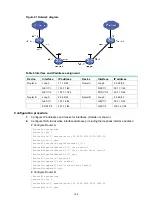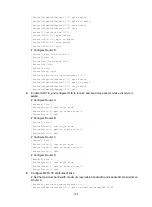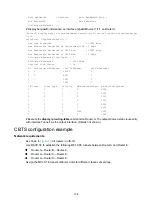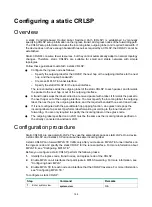
160
4.
Use RSVP-TE to establish three MPLS TE tunnels: Tunnel 1, Tunnel 2, and Tunnel 3. Tunnel 1
uses path Router A—Router B—Router E. Tunnel 2 uses path Router A—Router C—Router E.
Tunnel 3 uses path Router A—Router D—Router E. (Details not shown.)
5.
Configure a QoS policy on Router A.
# Create a traffic class.
<RouterA> system-view
[RouterA] traffic classifier class
[RouterA-classifier-class] if-match any
[RouterA-classifier-class] quit
# Create a traffic behavior.
[RouterA] traffic behavior behave
[RouterA-behavior-behave] remark service-class 3
[RouterA-behavior-behave] quit
# Create a QoS policy.
[RouterA] qos policy policy
[RouterA-qospolicy-policy] classifier class behavior bahave
[RouterA-qospolicy-policy] quit
# Apply the QoS policy to GigabitEthernet 1/1/4.
[RouterA] interface GigabitEthernet 1/1/4
[RouterA-GigabitEthernet1/1/4] qos apply policy policy inbound
[RouterA-GigabitEthernet1/1/4] quit
6.
Set the CoSs for the MPLS TE tunnels.
# Set the CoS to 3 for Tunnel 2.
[RouterA] interface tunnel 2 mode mpls-te
[RouterA-Tunnel2] mpls te service-class 3
[RouterA-Tunnel2] quit
# Set the CoS to 6 for Tunnel 3.
[RouterA] interface tunnel 3 mode mpls-te
[RouterA-Tunnel3] mpls te service-class 6
[RouterA-Tunnel3] quit
Verifying the configuration
# Display information about Tunnel 1 on Router A.
[RouterA]display mpls te tunnel-interface Tunnel 1
Tunnel Name : Tunnel 1
Tunnel State : Up (Main CRLSP up)
Tunnel Attributes :
LSP ID : 17419 Tunnel ID : 1
Admin State : Normal
Ingress LSR ID : 10.1.1.1 Egress LSR ID : 40.1.1.1
Signaling : RSVP-TE Static CRLSP Name : -
Static SRLSP Name : main1/-
Resv Style : -
Tunnel mode : -
Reverse-LSP name : -
Reverse-LSP LSR ID : - Reverse-LSP Tunnel ID: -
Class Type : - Tunnel Bandwidth : -
Reserved Bandwidth : -
















































